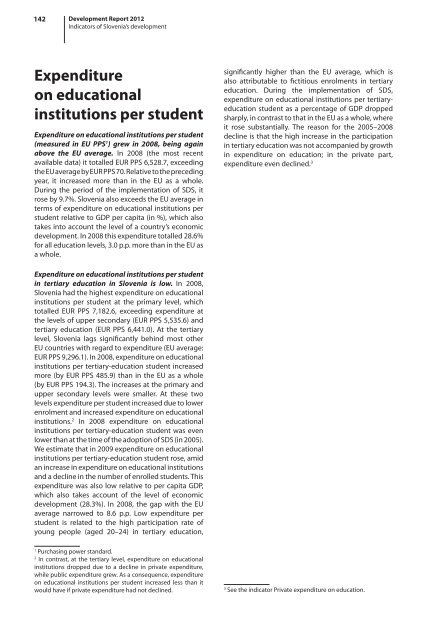development report 2012 - UMAR
development report 2012 - UMAR
development report 2012 - UMAR
Create successful ePaper yourself
Turn your PDF publications into a flip-book with our unique Google optimized e-Paper software.
142 Development Report <strong>2012</strong><br />
Indicators of Slovenia’s <strong>development</strong><br />
Expenditure<br />
on educational<br />
institutions per student<br />
Expenditure on educational institutions per student<br />
(measured in EU PPS 1 ) grew in 2008, being again<br />
above the EU average. In 2008 (the most recent<br />
available data) it totalled EUR PPS 6,528.7, exceeding<br />
the EU average by EUR PPS 70. Relative to the preceding<br />
year, it increased more than in the EU as a whole.<br />
During the period of the implementation of SDS, it<br />
rose by 9.7%. Slovenia also exceeds the EU average in<br />
terms of expenditure on educational institutions per<br />
student relative to GDP per capita (in %), which also<br />
takes into account the level of a country’s economic<br />
<strong>development</strong>. In 2008 this expenditure totalled 28.6%<br />
for all education levels, 3.0 p.p. more than in the EU as<br />
a whole.<br />
significantly higher than the EU average, which is<br />
also attributable to fictitious enrolments in tertiary<br />
education. During the implementation of SDS,<br />
expenditure on educational institutions per tertiaryeducation<br />
student as a percentage of GDP dropped<br />
sharply, in contrast to that in the EU as a whole, where<br />
it rose substantially. The reason for the 2005–2008<br />
decline is that the high increase in the participation<br />
in tertiary education was not accompanied by growth<br />
in expenditure on education; in the private part,<br />
expenditure even declined. 3<br />
Expenditure on educational institutions per student<br />
in tertiary education in Slovenia is low. In 2008,<br />
Slovenia had the highest expenditure on educational<br />
institutions per student at the primary level, which<br />
totalled EUR PPS 7,182.6, exceeding expenditure at<br />
the levels of upper secondary (EUR PPS 5,535.6) and<br />
tertiary education (EUR PPS 6,441.0). At the tertiary<br />
level, Slovenia lags significantly behind most other<br />
EU countries with regard to expenditure (EU average:<br />
EUR PPS 9,296.1). In 2008, expenditure on educational<br />
institutions per tertiary-education student increased<br />
more (by EUR PPS 485.9) than in the EU as a whole<br />
(by EUR PPS 194.3). The increases at the primary and<br />
upper secondary levels were smaller. At these two<br />
levels expenditure per student increased due to lower<br />
enrolment and increased expenditure on educational<br />
institutions. 2 In 2008 expenditure on educational<br />
institutions per tertiary-education student was even<br />
lower than at the time of the adoption of SDS (in 2005).<br />
We estimate that in 2009 expenditure on educational<br />
institutions per tertiary-education student rose, amid<br />
an increase in expenditure on educational institutions<br />
and a decline in the number of enrolled students. This<br />
expenditure was also low relative to per capita GDP,<br />
which also takes account of the level of economic<br />
<strong>development</strong> (28.3%). In 2008, the gap with the EU<br />
average narrowed to 8.6 p.p. Low expenditure per<br />
student is related to the high participation rate of<br />
young people (aged 20–24) in tertiary education,<br />
1<br />
Purchasing power standard.<br />
2<br />
In contrast, at the tertiary level, expenditure on educational<br />
institutions dropped due to a decline in private expenditure,<br />
while public expenditure grew. As a consequence, expenditure<br />
on educational institutions per student increased less than it<br />
would have if private expenditure had not declined.<br />
3<br />
See the indicator Private expenditure on education.
















